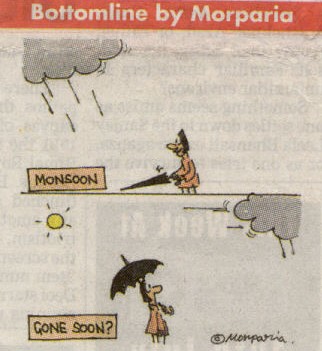
 Pune Times, July 20, 2002
|
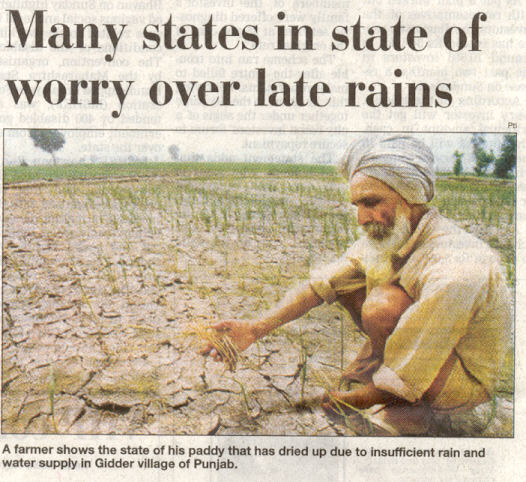
New Delhi: Officials of the Union agriculture ministry are getting increasingly worried at the prolonged absence of rain in many parts of the country.
“The monsoon began well, but now, barring the north-east, since around June 25, it has been very weak and there has been little progress”, says a worried Chittaranjan Hazra, agriculture commissioner. "The crucial period (for crops) is June 15 to July 15. Now, with every day's delay, the situation becomes more serious. If it is delayed by two more weeks, the situation will become very serious."
Hemendra Kumar, the ministry's special secretary, says this is unnecessarily gloomy. "The monsoon has been delayed only over the north-west (Punjab, Haryana and north Rajasthan). The average rainfall, if aggregated all over the country, is still 99 per cent of the long-term figure."
But he, too, agrees that if the heavens don't relent in the next two weeks, there is likely to be a problem. And relief measures to farmers - easier credit, new seeds, drought-relief - will have to be taken.
The current lack of rains comes on top of existing problems: many areas of Madhya Pradesh have been facing drought for at least three years. Rajasthan too has had a bad time in that period. So has Gujarat, Haryana and Punjab which continue to overdraw on underground water without enough recharge.
Many other states are restive: Maharashtra, Andhra Pradesh and Karnataka are already complaining of drought problems in many parts while Tamil Nadu wants Cauvery water, which its neighbour, Karnataka, says it won't, or can't, give.
The Centre can give advice and be ready with technical help and, the cash-deficit treasury permitting, more money. But the action will have to be taken by state governments. The countdown, therefore, may begin in a fortnight if the picture remains the same.
Times of India, Pune, July 16, 2002.
TopTIMES NEWS NETWORK [ TUESDAY, JULY 09, 2002 11:28:20 PM ]
PTI [ TUESDAY, JULY 16, 2002 9:52:39 PM ]
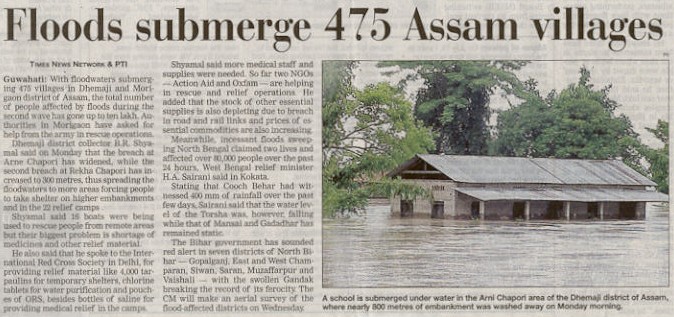
Times of India, Pune, July 24, 2002.
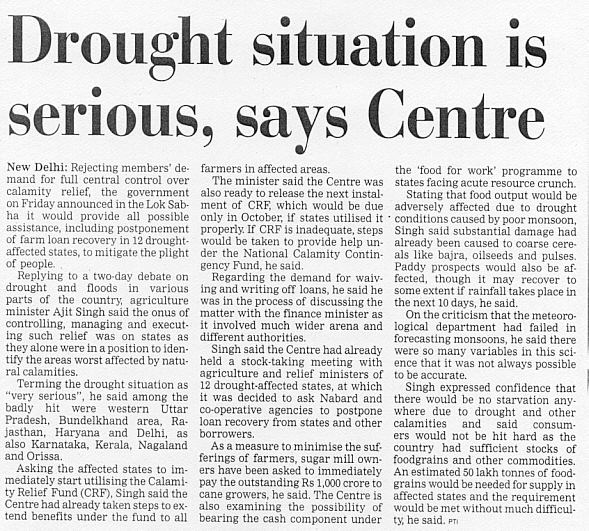
Times of India (Headlines), Pune, July 27, 2002.
As the drought shadow lengthens over large parts of North and Central India the question troubling everyone is what caused the failure of the monsoons this year. Sonu Jain looks at some of the possible answers
FACT ONE: The monsoons have failed. Everyone agrees on this one. The country is on the verge of the worst-ever drought, since rainfall has been nearly 35 per cent less than normal.
FACT TWO: The Indian Meteorology Department has been proven horribly wrong: Earlier this year, it had announced to the world that India would have its 14th consecutive normal monsoon.
If the Met department is to be believed, these are the only facts that can be taken for granted; the rest is uncertainty.
So what makes the Indian monsoon so mysterious? Why can't the most advanced forecasting techniques predict the weather? So much so that when the monsoons decide to skip large swathes of the country, nobody really knows why?
That is not to imply our knowledge hasn't grown much from the time the phrase 'monsoon' was coined by Arab mariners in reference to the seasonal winds in the Indian Ocean. We know the monsoons are found in Australia and West Africa as well, though nowhere is it more dramatic or more vital to the economy.
We also know how the monsoons are supposed to work. Moisture-bearing winds are attracted to the summer-roasted Indian landmass from the cold Indian Ocean. Once the winds cross the equator, they turn in the South-Westerly direction and shed their load over the heated peninsula, bringing rain. So far, even a Class V geography student could tell you.
What happens after this, however, is more complex. The now-dry winds move to the Bay of Bengal, where a convection system - essentially a low pressure area spread over at least a five sq km area - forms, and pick up moisture again. Simultaneously, a monsoon trough, another large low pressure area extending from Rajasthan to West Bengal, forms over the landmass. Winds moving in a cyclonic motion over the Bay of Bengal are pulled towards this trough and turn eastwards, bringing rain to North and Central India.
So what went wrong this year? It's tough to pin-point an answer, since day-to-day variations do not give any clues to the larger seasonal picture. "In real time, it is not possible to arrive at conclusions," says K Rupa Kumar, scientist with the Indian Institute of Tropical Meteorology.
Scientists call it 'a peculiar phenomenon', something which they have not seen in the past. "A break situation has occurred even before the monsoon could develop fully," says Rupa Kumar. The break normally happens after the monsoon is well in progress.
In layman's language, it means that the two low pressure areas over the Bay of Bengal and the Indian landmass weaken even before they begin to form. The result: drizzles, not deluges.
Theories abound over why this has happened:
The correlation between the warm ocean currents off the South American coast and India is not very clear, but the El Niño may be responsible for the shift in the convection areas over the Bay of Bengal. Across the globe, the El Niño, and the consequent warming of the ocean currents, has affected ocean currents, leading to major shifts in weather patterns. Of late, a number of foreign agencies have issued advisories on the revival of the El Niño, but Rupa Kumar is reluctant to lay the blame of the monsoon failure at its door. "The impact of the El Niño was felt months after it was detected off the Peru coast. It's too early for it too impact us now," he says. As a result, the IMD did not include the El Niño as one of the parameters for the monsoon forecast.
Even as they study these possibilities, Met officials are keeping their fingers crossed that the monsoon will get revived by the middle of August. "As long as there are clouds over the Bay of Bengal, there is hope," says a Met scientist.
The Indian Express, August 4, 2002
As far as the rains are concerned, it is already too little, too late. But one bad monsoon does not ruin the economy, bad policy does, says agriculture expert Yoginder K Alagh
Even if we eventually have what is euphemistically called a ‘normal monsoon’ this year substantial damage has already been done to the crops. The focus, then, should shift to helping those who have already suffered.
Arguably, given our experience and advances in science, we are definitely better placed to face adverse weather today than we were in 1987, the worst drought in the last one-and-a-half decade. No doubt, the RBI was quick to announce that the drought would not affect the growth rate. I agree, but with a caveat: provided proper policies are followed. It is not the failure of monsoon that leads to the failure of the economy. It is simply the pursuit of bad policies.
Unfortunately, the RBI has nothing to say on the damage caused by the drought. Does it have anything to say why good policies pursued in the past have suddenly been stopped? Not really. Consider the example of the Kapur Committee. It went into the details of cooperative credit (which still accounts for a large part of rural finance) that NABARD was associated in the early ’90s. It had experimented with loans for watershed development, rain harvesting and storage projects in arid agro-climatic regions. But the experiment was stopped mid-way, no reasons given.
|
THE NORTHERN DISCOMFORT
|
 |
The Kapur Committee had suggested launching the cooperative credit plan once again and focused on how to become ‘drought proof friendly’. Rural credit availability and rescheduling of loans for crop failure was an essential part of drought-fighting strategies in the past. Credit reforms were without any re-payment waivers of the type witnessed in 1990-91. Such giveaways, however, broke the back of the rural credit system.
If the farmer is to plant again this year we need a functioning rural credit system. The emphasis should be on prevention not on cure. Under political pressure successive governments end up spending enormous amounts on relief. But reform of the lending systems to make them ‘drought proof friendly’ is never on the agenda.
Many of the obstacles to fighting adverse weather conditions lie outside the Agriculture Ministry. That is why success in fighting droughts is achieved only if co-ordinating mechanisms at the Cabinet and Committee of Secretaries level are set up, as in 1987.
In 1987, the Planning Commission, the PMO and the Cabinet Secretariat succeeded because they coordinated wonderfully. Resources are available today. The problem is convergence.
What is to be done
• We must believe that fighting drought is good policy.
Credit reform and better water policies are a must.
• A Crisis Management Group must arrange for agricultural inputs. We must
involve the private sector particularly large corporates involved in input
supply.
• Since the State no longer plays a significant role in seeds, pesticides
and fertilisers supply it must co-ordinate with the corporates. Let us appeal
to their corporate social responsibility.
• In the late ’80s, breeder support was provided to the agricultural universities.
Let us repeat it for rabi and filler crops in the dry areas. By mid-August,
a group with rudimentary skills in hydrology should be able to forecast the
situation.
• Around 20 reservoirs may need emergency operating plans. Severe control
on non-agricultural use and careful balancing of agricultural and drinking
water needs will be required together with alternative ways to fund it.
• Fortunately, the Advanced Irrigation Benefit Programme has been in place
for the last seven years. Moreover, the Budget had announced that it would
be extended to distribution systems as well.
• As an emergency measure, the Tubewell Irrigation Programme implemented
by the Government in the Eastern region should be extended to the drought-hit
areas. This should be the year for a large number of small projects to conserve,
store and distribute water.
• Rural women are adversely affected. An employment programme and the PDS
for the really hungry is urgently needed. This must first involve women and
women-headed households.
• Does the Indian economy have to fare poorly each time there is a monsoon
failure? Given its size and depth it shouldn’t. What is important is pursuing
good policies.
(The writer is a former minister of state for Planning & S&T)
The Indian Express, August 4, 2002
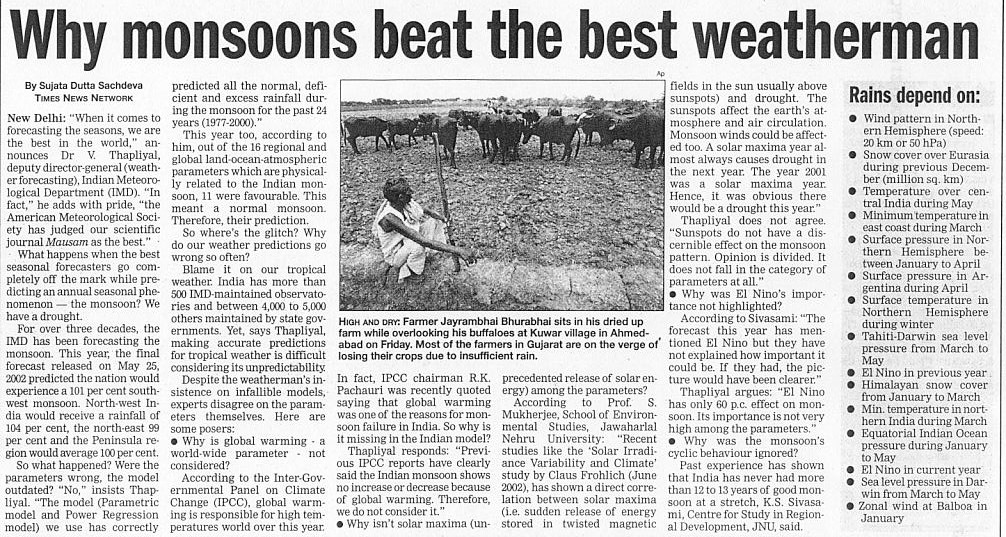
Times of India (Headlines), Pune, August 4, 2002.
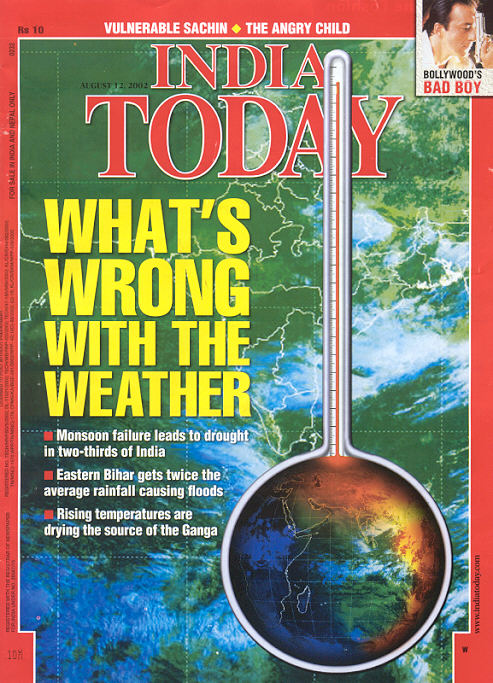
India Today (Cover Story), August 12, 2002.
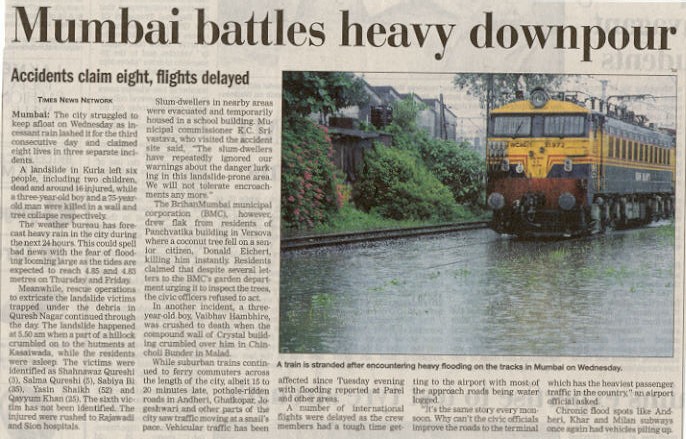
Times of India (Headlines), Pune, August 8, 2002.